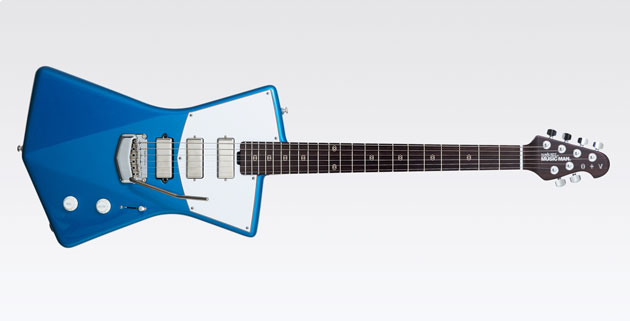 It’s no secret that many “artist signature” guitars aren’t all that different from a company’s stock models. Jigger with surface cosmetics, maybe tweak the electronics a bit, and voilà — you’ve got a “new” model to sell at an upmarket price.
It’s no secret that many “artist signature” guitars aren’t all that different from a company’s stock models. Jigger with surface cosmetics, maybe tweak the electronics a bit, and voilà — you’ve got a “new” model to sell at an upmarket price.
Music Man’s St. Vincent is nothing like that. Designed top to bottom by Annie “St. Vincent” Clark with help from the Ernie Ball/Music Man lutherie team, the instrument is as bold, imaginative, and thoughtful as Clark’s extraordinary guitar work.
Old-School Modern The St. Vincent’s angular, geometric body is unapologetically Modernistic—and that’s upper-case “Modernistic” in the mid-20th-century-design sense. Guitar history geeks will probably flash on 1957/1958, when Gibson created the Flying V, Explorer, and Moderne. Designed by visionary Gibson honcho Ted McCarty, these instruments (along with 1963’s Ray Dietrich-designed Firebird) aimed to update Gibson’s then-stodgy image with a bit of Fender’s space-age panache.
It’s easy to imagine the St. Vincent’s angular body in the McCarty sketchbook alongside the abstractly geometric V and Explorer. But the St. Vincent’s ergonomics are superior to those midcentury classics. Unlike the V, for example, Clark’s guitar is as comfortable to play seated as standing. The African mahogany body balances beautifully. There’s no conventional cutaway, but you have clearance up to the 19th fret, where you can position your index finger for easy access the top three frets. The upper and lower bouts are beveled slightly in relation to the guitar’s centerline, providing a Strat-like armrest and creating the illusion of a multicolored top in some lighting conditions. Clark even hand-mixed the steely-blue finish color. (The guitar is also available in black.)
Slight but Solid The St. Vincent weighs a mere 7 pounds, thanks to its svelte, slim-waisted body shape. It’s a great choice for players of smaller stature, or anyone whose back or shoulders object to overweight axes. But despite its modest weight and slender proportions, nothing about the St. Vincent feels insubstantial.
The stout rosewood neck has a 10" radius and a relaxed D shape. Its back is only lightly oiled, providing a raw-wood feel and a solid grip. The 25.5"-scale fretboard has 22 immaculately installed and rounded frets. The fulcrum-tremolo bridge is geared for quick, Van Halen-esque deep dives, but it’s also capable of subtle vibrato under an ultra-light touch. Pitch stability is about as good as it gets on guitars without locking trems. (The locking Schaller tuners help, as does the expertly installed and intonation-compensated nut.) Build quality is excellent across the board.
There are many cool cosmetic details, including the vertically oriented pickguard, triangular knobs, and interlocking-circle position markers. The only visual misstep for me is the standard Music Man headstock. I dig its compact yet elegant shape and offbeat 4+2 tuner layout, but to my eye, at least, its relaxed curves and pearloid tuner buttons don’t quite harmonize with the body’s clean angles and stark white plastic hardware. Having said that, the dark shade of the neck and headstock makes these elements recede into the background. Your eyes can’t help but focus on the bold blue body.
Wicked Wiring The guitar’s electronics are as unconventional as its angles. Clark opted for three mini-humbuckers—shades of Gibson’s Firebird VII. There’s a 5-way selector switch, but the pickups aren’t wired Strat-style. Positions 1, 2, and 3 solo each of the pickups. Position 4 combines all three pickups in parallel, while position 5 blends the outer two. You can’t get the sound of two combined adjacent pickups, as from Strat positions 2 and 4, but that’s cool—the all-three setting provides crisp, articulate “out-of-phase” sounds, and the neck and bridge harmonize gloriously.
I confess I’ve never owned a mini-humbucker guitar. These DiMarzios sound terrific, but it took me an hour or two of playing to get the hang of them. They have a snappy, focused attack compared to conventional humbuckers, and a more hair-trigger tonal response. They can seem dark at times, yet highs can erupt violently when you dig in. Once you get acclimated, though, they can be extraordinarily dynamic. Just be aware that they respond differently than most humbuckers or single-coils. Nor do they behave like P-90s, though, like P-90s, their clean tones tend to be rough-edged and “furry” relative to single-coils, while distorted tones usually have more snap and string-to-string differentiation than on humbucker guitars.
The St. Vincent doesn’t lack low end power, but macho chunk isn’t its strong suit. Heavily overdriven tones tend to evoke early Zep or AC/DC, with crisp attack and strong note definition. Nor is the guitar terribly twangy—clean tones maintain bulk, and you never get anything quite like, say, a soloed bridge pickup on a Strat or Tele. But these aren’t complaints. I dig the St. Vincent’s unique voice and the way it adds new colors to your palette. And whether you play clean, dirty, or in-between, you’ll appreciate the excellent intonation and rich, ringing sustain.
The Verdict Annie Clark’s signature model is visually striking. But its distinctiveness is more than skin-deep. Its superb ergonomics are perfect for players seeking a big-guitar sound from a light, lean-bodied instrument. The build quality is excellent. Three mini-humbuckers and unconventional wiring provide many distinctive tones, all of which benefit from the guitar’s fine intonation and great natural sustain. The price may seem steep for a solidbody with a bolt-on neck, but this is a unique new design, and the detail work and setup are fantastic. (Some skilled technician invested substantial bench time fine-tuning this instrument.) The St. Vincent is as cool, clever, and engaging as, well, a new St. Vincent album.
